Pipeline cleaning and flushing is an important aspect of cleanup and maintenance in any offshore or land operation.
There are a couple of primary types of pipe flushing you should be aware of:
- Chemical flushing: Also known as “pickling,” this process is performed to remove dirt, debris, grease, rust, oil, scale, and other substances that build on the pipelines. The process removes a thin layer of the surface of the pipe wall and all contamination. It also reduces the cost of oil flushing that may be performed later.
- Oil flushing: This process is performed to ensure the pipelines and the operation oil are clean and contaminant-free. Oil flushing typically occurs after the chemical flushing process in lube oil or hydraulic systems.
In both cases, the flushing process involves loosening and removing particles of contaminants by forcing a fluid through the pipeline at a high velocity. Flushing must be accomplished at normal fluid velocities for a set period of time with a certain level of filtration in the system, though in some cases there might also be requirements for certain fluid contamination levels.
With oil flushing, the process must continue until you reach the target cleanliness code.
What makes this process necessary?
There are a lot of compliance standards that exist with maintaining or decommissioning pipelines. A failure to properly clean or flush pipelines in offshore or land applications could result in a lack of compliance with these standards, which opens a company up to potential fines or legal troubles.
Pipeline cleaning also decreases the risk of potential failure. Over time, the deterioration and corrosion of pipelines can make them significantly more likely to fail. In fact, some estimates indicate that as many as 65 percent of pipeline failures across the world are a result of corrosion.
This is why an increasing number of pipeline integrity laws have been put on the books. In the United States, the Pipeline Integrity Bill exists to ensure pipelines are inspected for their integrity every five years if they are transporting liquid and every seven years if they are transporting natural gas.
Engaging in a regular pipeline cleaning and flushing regimen reduces the risk of leakage and failure, which prevents potentially catastrophic damage to natural environments and waterways as well as the loss of a massive dollar amount of liquid or gas.
Permitting & Compliance
There are a lot of regulatory requirements operators must comply with during the decommissioning phase. Operators must make sure they meet these requirements before proceeding with decommissioning work.
One step is obtaining permits for decommissioning, which itself may take up to three years. Operators typically work with consultants to obtain all necessary permits before decommissioning. Local consultants are best, as they understand the regulatory requirements for the region.
Operators will also create an Execution Plan, which contains thorough environmental information and surveys of the project site. The plan contains instructions and information about decommissioning activities and when they will occur, as well as all the equipment and personnel that will be needed for that process.
The operator may need to work with various federal agencies in ensuring their regulatory compliance and obtaining permits. Again, it is crucial to give paperwork with these agencies more than enough time to process, which is one reason why the decommissioning prep work begins years in advance.
Platform Preparation
Finally, there are some physical elements of preparation that must occur before decommissioning work can begin.
Teams must flush and clean all tanks, processing equipment and piping, and dispose of any existing residual hydrocarbons. Equipment on the platform must be moved, which may involve cutting pipes and cables, separating deck modules, installing lifts and performing structural reinforcement.
Teams may need to work underwater as well to remove marine growth on the structure before decommissioning can proceed.
Interested in learning more about the pipeline cleaning and flushing process? Contact our team at Ecoserv to learn more about the work we perform for the oil and gas industry.





